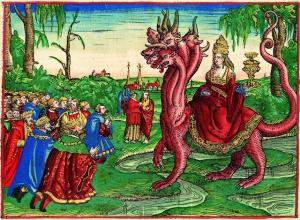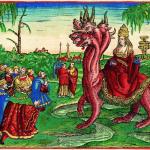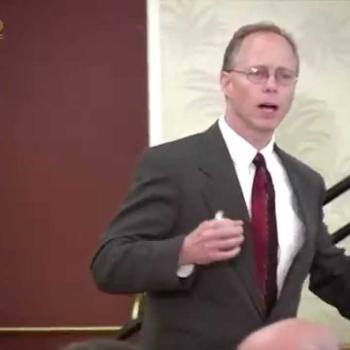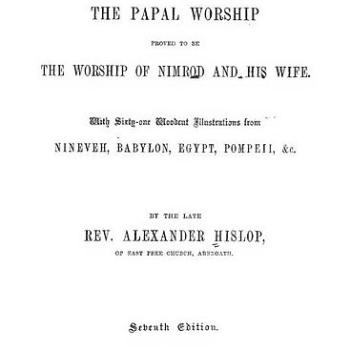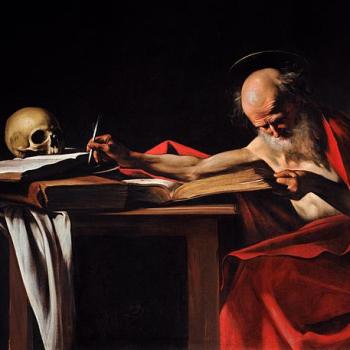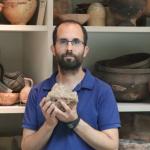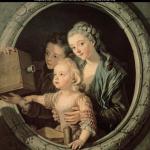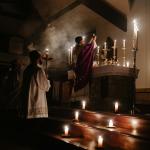Catholic Miracles Unfairly Criticized & Biblically Defended; St. Padre Pio; St. Joseph Cupertino
The late Steve Hays (1959-2020) was a Calvinist (and anti-Catholic) apologist, who was very active on his blog, called Triablogue (now continued by Jason Engwer). His 695-page self-published book, Catholicism — a collection of articles from his site — has graciously been made available for free. On 9 September 2006, knowing full well my history of being condemned and vilified by other anti-Catholics (and his buddies) like James White, Eric Svendsen, and James Swan, Hays was quite — almost extraordinarily — charitable towards me. He wrote then:
I don’t think I’ve ever accused him of being a traitor or apostate or infidel. . . . I have nothing to say, one way or the other, regarding his state of grace. But his sincerity is unquestionable. I also don’t dislike him. . . . I don’t think there’s anything malicious about Armstrong—unlike some people who come to mind. In addition, I don’t think I’ve ever said he was unintelligent. For the record, it’s obvious that Armstrong has a quick, nimble mind. . . . The term “apostasy” carries with it a heavy presumption that the apostate is a hell-bound reprobate. I think it’s unwarranted to assume that all Catholics or converts to Catholicism are damned.
Two-and-a-half years later, starting in April 2009 and up through December 2011 (in the following quotations) his opinion radically changed, and he claimed that I have “an evil character,” am “actually evil,” “ego-maniac, narcissist,” “idolater,” “self-idolater,” “hack who pretends to be a professional apologist,” given to “chicanery,” one who doesn’t “do any real research,” “a stalwart enemy of the faith . . . no better than [the atheists] Richard Dawkins or Christopher Hitchens,” with an intent to “destroy faith in God’s word,” “schizophrenic,” “emotionally unhinged,” one who “doesn’t trust in the merit of Christ alone for salvation,” “has no peace of mind,” “a bipolar solipsist,” “split-personality,” and a “bad” man. He wasn’t one to mince words! See more gory details.
I feel no need whatsoever to reciprocate these silly and sinful insults. I just wanted the record to be known. I’ve always maintained that Hays was a very intelligent man, but habitually a sophist in methodology; sincere and well-meaning, but tragically and systematically wrong and misguided regarding Catholicism. That’s what I’m addressing, not the state of his heart and soul (let alone his eternal destiny). It’s a theological discussion. This is one of many planned critiques of his book (see my reasons why I decided to do this). Rather than list them all here, interested readers are directed to the “Steve Hays” section of my Anti-Catholicism web page, where they will all be listed. My Bible citations are from the RSV. Steve’s words will be in blue.
*****
[Chapter 1: Miracles]
Parsing Catholic miracles
[T]e Martyrdom of Polycarp says he was fireproof when the Romans tried to burn him alive. Assuming that’s true, should that be classified as a Catholic miracle? [p. 16]
Yes.
Was Polycarp Roman Catholic? [p. 16]
Yes, of course.
Or is that an anachronistic designation? [p. 16]
Not at all. He was a member of the one true Church begun by Jesus, under the initial human leadership of St. Peter, and then under his successors to the papal office. That Church is demonstrably historically continuous to this day. Polycarp rejected sola Scriptura and sola fide (faith alone): the two “pillars” of the Protestant Revolution. He regarded Tobit, the Didache, and Ecclesiasticus as Holy Scripture. That’s either being simply a “Catholic” (as I would contend) or (as it seems anyone is obliged to hold) at the very least more Catholic than proto-“Protestant”, since he denied the two pillars which supposedly sum up the main tenets and distinctives of the Protestant revolt, which had to wait until 1362 years after his death.
He wasn’t Catholic in the sense that Ignatius Loyola was Catholic, or Matthias Joseph Scheeben–much less Joseph Ratzinger. [p. 16]
Of course he wasn’t. He lived in the first and second centuries. I could turn it around and say that “Hays wasn’t a Calvinist in the sense that John Calvin was a Calvinist.” But he was still a Calvinist! All those hundreds of years since Polycarp saw much development of doctrine and practice. That’s why he is different from the later figures, but it’s not an essential difference. It’s the difference between an acorn and an oak tree: the former develops inexorably into the latter, and the DNA was the same all along. The acorn is an oak tree in the making, or a “very young” oak tree, as it were.
Consider the cult of Padre Pio. There’s evidence that he used carbonic acid. If so, his stigmata might be the result of self-mutilation. [p. 17]
Prove it, then! Put your money where your mouth is! This is the constant unethical method of anti-Catholic polemicists: to throw out a serious charge but not to take enough time to document it and make the case on the grounds of factuality and plausibility: just as in any other form of honest research. Failing that, it’s simply gossip and rumormongering, which is clearly unethical. Some people will read something like this and never forget it, and never look into it to verify or disprove it. And if it’s false, it was bearing false witness on Hays’ part: a violation of one of the Ten Commandments.
Readers may wish to read a favorable report of St. Pio’s stigmata, and when they began. The date was September 20, 1918. The scurrilous claim is that St. Pio asked for the acid in the “summer of 1919,” some 9-10 months after his stigmata began. The acid could hardly have caused [what would then merely mimic] the stigmata, let alone promulgate a complete fakery. False accusations against St. Padre Pio (like those against Jesus and Paul) are nothing new.
Saints are often persecuted not only by anti-Catholics, but (sadly) by those in the Church. The Holy See in 1931 ordered St. Padre Pio to cease public ministry and offering Mass in public, cease hearing confessions, and to not make any public appearances. He was also accused by some of insanity and fraud. In 1960, the Vatican again restricted his public ministry based on the notion that his popularity had gotten out of control. In that year, one Fr. Carlo Maccari accused the 73-year-old Padre Pio of having sex with female penitents “twice a week.” Fr. Maccari later admitted that he had lied and asked for forgiveness in a public recantation on his deathbed in 1961. St. Pio’s stigmata wounds completely vanished three days before he died.
In principle, some eucharistic miracles might be staged. A homemade communion wafer with ingredients designed to have a chemical reaction that simulates blood when immersed in wine. Or actual human blood could be one of the ingredients. [p. 17]
Yes, maybe so. But this proves absolutely nothing with regard to purported miracles of this sort that produced verified human blood and had strict controls against manipulation by unscrupulous folks. The presence of a counterfeit dollar bill doesn’t disprove all genuine dollar bills. This is not an argument. It’s simply a statement of the obvious truism that there are people out there who may try to fake miracles for a thrill or money or anti-Catholic motives; on a dare, whatever!
The miracles attributed to St. Joseph Copertino include levitation, psychokinesis, poltergeist activity, and materialization of objects. Even if genuine, there’s nothing specifically Christian about that phenomena. . . . there’s nothing specifically divine about such phenomena. If genuine, it’s more like a supernatural stunt. They fail to exhibit divine wisdom, justice, mercy, holiness, and truth. We’d expect a divine miracle to have a certain dignity or fittingness. Not just be something weird or frivolous. From what I’ve read, there’s a connection between possession and levitation. [pp. 17-18]
This is a rather bizarre argument. How is “materialization of objects” different in essence from Jesus multiplying the loaves and the fish? Did not Jesus materialize those two things, in abundance? Was that miracle not “specifically Christian”? Was it not “divine”: having been done by the express will of Jesus, Who is God? Should it be properly described as a “supernatural stunt”? What in the world was Hays thinking here? Or was he not thinking at all when he made the charges, in his ever-present prejudice against Catholicism? Did the feeding of the five and four thousand not “exhibit divine wisdom, justice, mercy, holiness, and truth”? Did it lack “dignity” and “fittingness”? Was it “weird or frivolous”? Talk about rhetorical overkill! We’re gonna see it a lot, believe me, folks, as I go through this book. All of these terms, by direct analogy, would apply to the two feeding miracle-events. Thus, Hay’s argument collapses in a spectacular reductio ad absurdum.
The same reductio amply applies to his bashing of “levitation” as well (which he associates — obviously “poisoning the well” — with “possession”: a nice touch there). That involves a person going up into the air in a supernatural fashion. Elijah did that (with the extra spectacle of a chariot and fire). Our Lord Jesus ascended (I visited the spot in 2014). At the Second Coming, millions of the elect will be “caught up . . . in the clouds to meet the Lord in the air” (1 Thess 4:17). The “two witnesses” of Revelation (11:3) were dead, but then “a breath of life from God entered them, and they stood up on their feet, and great fear fell on those who saw them. Then they heard a loud voice from heaven saying to them, ‘Come up hither!’ And in the sight of their foes they went up to heaven in a cloud” (Revelation 11:11-12).
That’s four scriptural instances of “ascensions” of one sort or another. Certainly these events were more lacking in “dignity” and “fittingness” and “weird or frivolous” than mere levitation, which is a very small analogy to an ascension. Therefore, if instances of levitation are regarded in this hostile fashion, how is it that the four biblical ascensions are not? What is the big difference? Well, the only one that is worth mentioning is that the one thing is said to be specifically “Catholic” and the others aren’t. Therefore, the scorn and derision is heaped on the Catholic miracle, with complete hypocrisy and a double standard (certainly not utilizing reason). When severe bias is always in the picture, this is the sort of incoherent “reasoning” we see. It’s equal parts pitiful and pathetic.
Moreover, “psychokinesis” is the moving of objects by mental activity alone. We have no problem finding many biblical parallels to this, too: Jesus calming the waves and the storm, and causing Lazarus to be raised and to walk out of his tomb, and legs suddenly being able to walk, the stone in front of Jesus’ tomb moving away from the entrance, etc. This means that all the name-calling that Hays made about this and the other “Catholic” miracles should consistently be applied to the analogous biblical events that are even more dramatic and unusual.
As for “poltergeist activity” (noisy or frivolous ghosts), Scripture is filled with that, too, or at least things highly akin or similar. We have Samuel the prophet (not an impersonating demon!, as some claim) appearing to Saul, Moses and Elijah appearing and talking to Jesus at His transfiguration, the two witnesses of Revelation 11, “many bodies of the saints who had fallen asleep” who “were raised, and coming out of the tombs after his resurrection they went into the holy city and appeared to many” (Mt 27:52-53). We have Jesus in effect walking through a wall to appear to His disciples after His resurrection. He eats fish with them. He closes the eyes of witnesses Mary Magdalene and the two disciples on the road to Emmaus, then reveals to them His identity. We have an angel wrestling with Jacob. Are all these phenomena “weird or frivolous” and all the other nonsense that Hays spews about Catholic miracles?
I have provided biblical analogies for all four things he brought up. His rather weak and insubstantial “argument” has now been utterly demolished and pulverized, if I do say so.
***
Practical Matters: Perhaps some of my 4,200+ free online articles (the most comprehensive “one-stop” Catholic apologetics site) or fifty-one books have helped you (by God’s grace) to decide to become Catholic or to return to the Church, or better understand some doctrines and why we believe them.
Or you may believe my work is worthy to support for the purpose of apologetics and evangelism in general. If so, please seriously consider a much-needed financial contribution. I’m always in need of more funds: especially monthly support. “The laborer is worthy of his wages” (1 Tim 5:18, NKJV). 1 December 2021 was my 20th anniversary as a full-time Catholic apologist, and February 2022 marked the 25th anniversary of my blog.
PayPal donations are the easiest: just send to my email address: apologistdave@gmail.com. You’ll see the term “Catholic Used Book Service”, which is my old side-business. To learn about the different methods of contributing, including 100% tax deduction, etc., see my page: About Catholic Apologist Dave Armstrong / Donation Information. Thanks a million from the bottom of my heart!
***
Photo credit: The Whore of Babylon (workshop of Lucas Cranach): colorized illustration from Martin Luther’s 1534 translation of the Bible [public domain / Wikimedia Commons]
***
Summary: The late Steve Hays was a Calvinist and anti-Catholic writer and apologist. This is one of my many critiques of Hays’ “Catholicism”: a 695-page self-published volume.


